Synthesis of Well-Defined Poly(N-H Benzamide-co-N-Octyl Benzamide)s and the Study of their Blends with Nylon 6
Abstract
:1. Introduction
2. Materials and Methods
2.1. Materials
2.2. Synthesis of P(M3OOB-co-M4OB) via CGCP
2.3. Selective Removal of 4-(octyloxy)benzyl Group (OOB) from PBAs
2.4. Blend Preparation of PNHBA and NY6
2.5. Characterization
3. Results and Discussion
4. Conclusions
Supplementary Materials
Acknowledgments
Author Contributions
Conflicts of Interest
References
- Krausch, G. Surface-induced self-assembly in thin polymer-films. Mater. Sci. Eng. R 1995, 14, 1–94. [Google Scholar] [CrossRef]
- Coleman, M.M.; Graf, J.F.; Painter, P.C. Specific Interactions and the Miscibility of Polymer Blends; Technomic Publishing: Lancaster, UK, 1991. [Google Scholar]
- Hu, J.B.; Painter, P.C.; Coleman, M.M.; Krizan, T.D. Toward a prediction of the phase-behavior of polyamide blends. J. Polym. Sci. Part B Polym. Phys. 1990, 28, 149–176. [Google Scholar] [CrossRef]
- Coleman, M.M.; Skrovanek, D.J.; Painter, P.C. Hydrogen-bonding in polymers. 3. Further infrared temperature studies of polyamides. Makromol. Chem. Macromol. Symp. 1986, 5, 21–33. [Google Scholar] [CrossRef]
- Wang, C.-F.; Su, Y.-C.; Kuo, S.-W.; Huang, C.-F.; Sheen, Y.-C.; Chang, F.-C. Low-surface-free-energy materials based on polybenzoxazines. Angew. Chem. Int. Ed. 2006, 45, 2248–2251. [Google Scholar] [CrossRef] [PubMed]
- Huang, C.-F.; Kuo, S.-W.; Lin, F.-J.; Huang, W.-J.; Wang, C.-F.; Chen, W.-Y.; Chang, F.-C. Influence of PMMA-chain-end tethered polyhedral oligomeric silsesquioxanes on the miscibility and specific interaction with phenolic blends. Macromolecules 2006, 39, 300–308. [Google Scholar] [CrossRef]
- Huang, C.-F.; Kuo, S.-W.; Lin, F.-J.; Wang, C.-F.; Hung, C.-J.; Chang, F.-C. Syntheses and specific interactions of poly(hydroxyethyl methacrylate-b-vinyl pyrrolidone) diblock copolymers and comparisons with their corresponding miscible blend systems. Polymer 2006, 47, 7060–7069. [Google Scholar] [CrossRef]
- Huang, C.-F.; Chang, F.-C. Comparison of hydrogen bonding interaction between PMMA/PMAA blends and PMMA-co-PMAA copolymers. Polymer 2003, 44, 2965–2974. [Google Scholar] [CrossRef]
- Ellis, T.S. Miscibility in blends of aliphatic polyamides and an aromatic polyamide, Nylon 3Me6T. Polymer 1988, 29, 2015–2026. [Google Scholar] [CrossRef]
- Ellis, T.S. Miscibility and immiscibility of polyamide blends. Macromolecules 1989, 22, 742–754. [Google Scholar] [CrossRef]
- Ellis, T.S. Aromatic polyamide blends—Enthalpy relaxation and its correlation with phase phenomena. Macromolecules 1990, 23, 1494–1503. [Google Scholar] [CrossRef]
- Ellis, T.S. Critical miscibility limits in blends of aliphatic polyamides containing an aromatic polyamide. Polymer 1990, 31, 1058–1064. [Google Scholar] [CrossRef]
- Ellis, T.S. The role of repulsive interactions in polyamide blends. Polym. Eng. Sci. 1990, 30, 998–1004. [Google Scholar] [CrossRef]
- Ellis, T.S. Influence of structure on phase-behavior of polyamide blends. Macromolecules 1991, 24, 3845–3852. [Google Scholar] [CrossRef]
- Ellis, T.S. Mixing relationships in aliphatic polyamide blends. Polymer 1992, 33, 1469–1476. [Google Scholar] [CrossRef]
- Ellis, T.S. Polyamide polyester blends—An estimation of the amide-ester interaction. J. Polym. Sci. Part B Polym. Phys. 1993, 31, 1109–1125. [Google Scholar] [CrossRef]
- Ellis, T.S. Estimating interactions in blends of polyamides, polyesters and polycarbonate using copolymers. Macromol. Symp. 1996, 112, 47–54. [Google Scholar] [CrossRef]
- Ellis, T.S. Phase behaviour of polyamide-polyester blends: The influence of aromaticity. Polymer 1997, 38, 3837–3841. [Google Scholar] [CrossRef]
- Ridhore, A.; Jog, J. Synergistic mechanical response of Nylon 6/Trogamid® T blends. J. Appl. Polym. Sci. 2013, 129, 65–72. [Google Scholar] [CrossRef]
- Yokozawa, T.; Asai, T.; Sugi, R.; Ishigooka, S.; Hiraoka, S. Chain-growth polycondensation for nonbiological polyamides of defined architecture. J. Am. Chem. Soc. 2000, 122, 8313–8314. [Google Scholar] [CrossRef]
- Yokozawa, T.; Ogawa, M.; Sekino, A.; Sugi, R.; Yokoyama, A. Chain-growth polycondensation for well-defined aramide. Synthesis of unprecedented block copolymer containing aramide with low polydispersity. J. Am. Chem. Soc. 2002, 124, 15158–15159. [Google Scholar] [CrossRef] [PubMed]
- Yokoyama, A.; Yokozawa, T. Converting step-growth to chain-growth condensation polymerization. Macromolecules 2007, 40, 4093–4101. [Google Scholar] [CrossRef]
- Yokozawa, T.; Yokoyama, A. Chain-growth condensation polymerization for the synthesis of well-defined condensation polymers and π-conjugated polymers. Chem. Rev. 2009, 109, 5595–5619. [Google Scholar] [CrossRef] [PubMed]
- Masukawa, T.; Yokoyama, A.; Yokozawa, T. Synthesis of well-defined polybenzamide-block-polystyrene by combination of chain-growth condensation polymerization and RAFT polymerization. Macromol. Rapid Commun. 2009, 30, 1413–1418. [Google Scholar] [CrossRef] [PubMed]
- Ohishi, T.; Sugi, R.; Yokoyama, A.; Yokozawa, T. Synthesis via chain-growth condensation polymerization and gelating properties of a variety of block copolymers-of meta- and para-substituted aromatic polyamides. Macromolecules 2008, 41, 9683–9691. [Google Scholar] [CrossRef]
- Huang, C.F.; Yokoyama, A.; Yokozawa, T. Synthesis of polybenzamide-b-polystyrene block copolymer via combination of chain-growth condensation polymerization and atom transfer radical polymerization. J. Polym. Sci. Part A Polym. Chem. 2010, 48, 2948–2954. [Google Scholar] [CrossRef]
- Huang, C.-F.; Ohta, Y.; Yokoyama, A.; Yokozawa, T. Efficient low-temperature atom transfer radical coupling and its application to synthesis of well-defined symmetrical polybenzamides. Macromolecules 2011, 44, 4140–4148. [Google Scholar] [CrossRef]
- Yamazaki, Y.; Yokoyama, A.; Yokozawa, T. Three-arm star block copolymers of aromatic polyether and polystyrene from chain-growth condensation polymerization, atom transfer radical polymerization, and click reaction. J. Polym. Sci. Part A Polym. Chem. 2012, 50, 3648–3655. [Google Scholar] [CrossRef]
- Yoshino, K.; Yokoyama, A.; Yokozawa, T. Well-defined star-shaped poly(p-benzamide) via chain-growth condensation polymerization: Use of tetra-functional porphyrin initiator to optimize star polymer formation. J. Polym. Sci. Part A Polym. Chem. 2009, 47, 6328–6332. [Google Scholar] [CrossRef]
- Yoshino, K.; Yokoyama, A.; Yokozawa, T. Synthesis of a variety of star-shaped polybenzamides via chain-growth condensation polymerization with tetrafunctional porphyrin initiator. J. Polym. Sci. Part A Polym. Chem. 2011, 49, 986–994. [Google Scholar] [CrossRef]
- Ohishi, T.; Masukawa, T.; Fujii, S.; Yokoyama, A.; Yokozawa, T. Synthesis of core cross-linked star polymers consisting of well-defined aromatic polyamide arms. Macromolecules 2010, 43, 3206–3214. [Google Scholar] [CrossRef]
- Sugi, R.; Hitaka, Y.; Yokoyama, A.; Yokozawa, T. Well-defined star-shaped aromatic polyamides from chain-growth polymerization of phenyl 4-(alkylamino)benzoate with multifunctional initiators. Macromolecules 2005, 38, 5526–5531. [Google Scholar] [CrossRef]
- Yamazaki, Y.; Ajioka, N.; Yokoyama, A.; Yokozawa, T. Synthesis of well-defined miktoarm star copolymers of aromatic polyether and polystyrene by chain-growth condensation polymerization and atom transfer radical polymerization. Macromolecules 2009, 42, 606–611. [Google Scholar] [CrossRef]
- Huang, C.-F.; Aimi, J.; Lai, K.-Y. Synthesis of novel μ-star copolymers with poly(N-octyl benzamide) and poly(ε-caprolactone) miktoarms through chain-growth condensation polymerization, styrenics-assisted atom transfer radical coupling, and ring-opening polymerization. Macromol. Rapid Commun. 2017, 38, 1600607. [Google Scholar] [CrossRef] [PubMed]
- Ohta, Y.; Fujii, S.; Yokoyama, A.; Furuyama, T.; Uchiyama, M.; Yokozawa, T. Synthesis of well-defined hyperbranched polyamides by condensation polymerization of AB2 monomer through changed substituent effects. Angew. Chem. Int. Ed. 2009, 48, 5942–5945. [Google Scholar] [CrossRef] [PubMed]
- Ohta, Y.; Kanou, T.; Yokoyama, A.; Yokozawa, T. Synthesis of well-defined, amphiphilic poly(ethylene glycol)-b-hyperbranched polyamide. J. Polym. Sci. Part A Polym. Chem. 2013, 51, 3762–3766. [Google Scholar] [CrossRef]
- Ohta, Y.; Kamijyo, Y.; Fujii, S.; Yokoyama, A.; Yokozawa, T. Synthesis and properties of a variety of well-defined hyperbranched N-alkyl and N-H polyamides by chain-growth condensation polymerization of AB2 monomers. Macromolecules 2011, 44, 5112–5122. [Google Scholar] [CrossRef]
- Ohta, Y.; Kamijyo, Y.; Yokoyama, A.; Yokozawa, T. Synthesis of well-defined, water-soluble hyperbranched polyamides by chain-growth condensation polymerization of AB2 monomer. Polymers 2012, 4, 1170–1182. [Google Scholar] [CrossRef]
- Harwood, H.J.; Ritchey, W.M. The characterization of sequence distribution in copolymers. J. Polym. Sci. Part B Polym. Phys. 1964, 2, 601–607. [Google Scholar] [CrossRef]
- Roman, S.J.; Madruga, E.L.; del Puerto, M.A. Radical copolymerization of acrylic monomers. V. Copolymerization of ortho- and para-chlorophenyl acrylates with methyl methacrylate. J. Polym. Sci. Polym. Chem. Ed. 1983, 21, 3303–3312. [Google Scholar] [CrossRef]
- Oswald, H.J.; Turi, E.A.; Harget, P.J.; Khanna, Y.P. Development of a middle endotherm in DSC thermograms of thermally treated drawn pet yarns and its structural and mechanistic interpretation. J Macromol. Sci. Phys. 1977, B13, 231–254. [Google Scholar] [CrossRef]
- Turi, E.A. Analytical Sciences at Allied, 3rd ed.; Academic Press: New York, NY, USA, 1981; p. 55. [Google Scholar]
- Khanna, Y.P.; Kuhn, W.P. Measurement of crystalline index in Nylons by DSC: Complexities and recommendations. J. Polym. Sci. Part B Polym. Phys. 1997, 35, 2219–2231. [Google Scholar] [CrossRef]

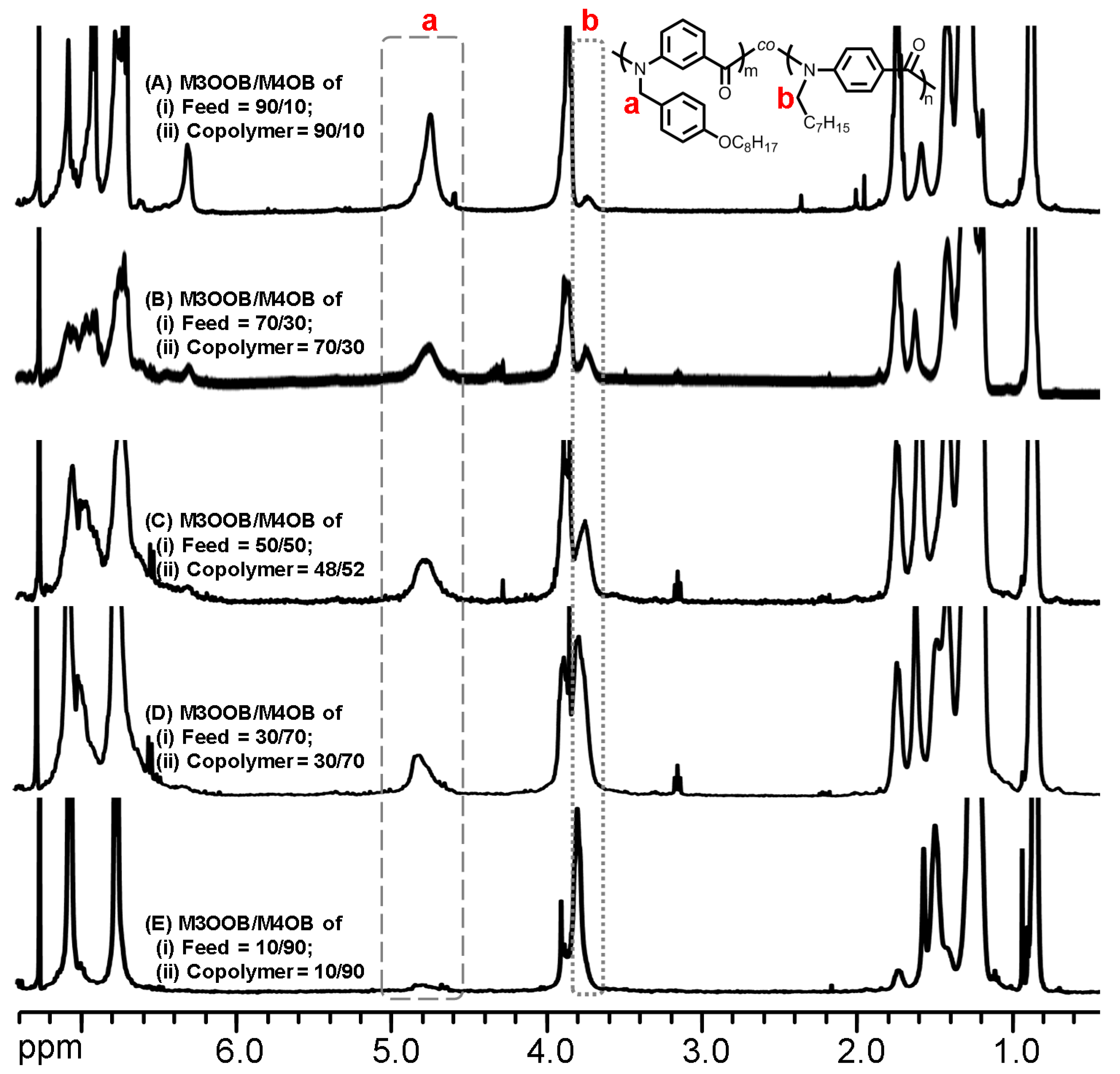
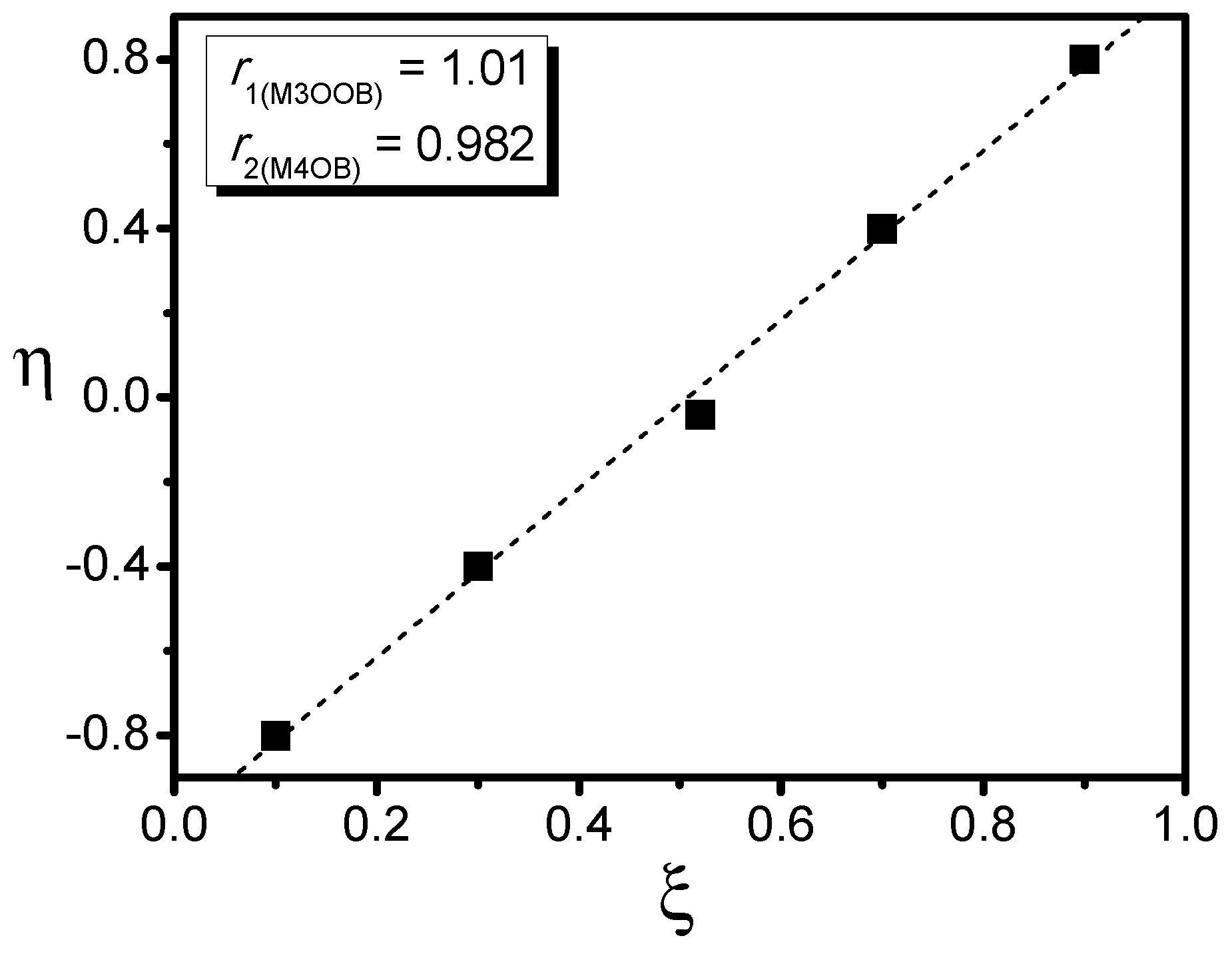
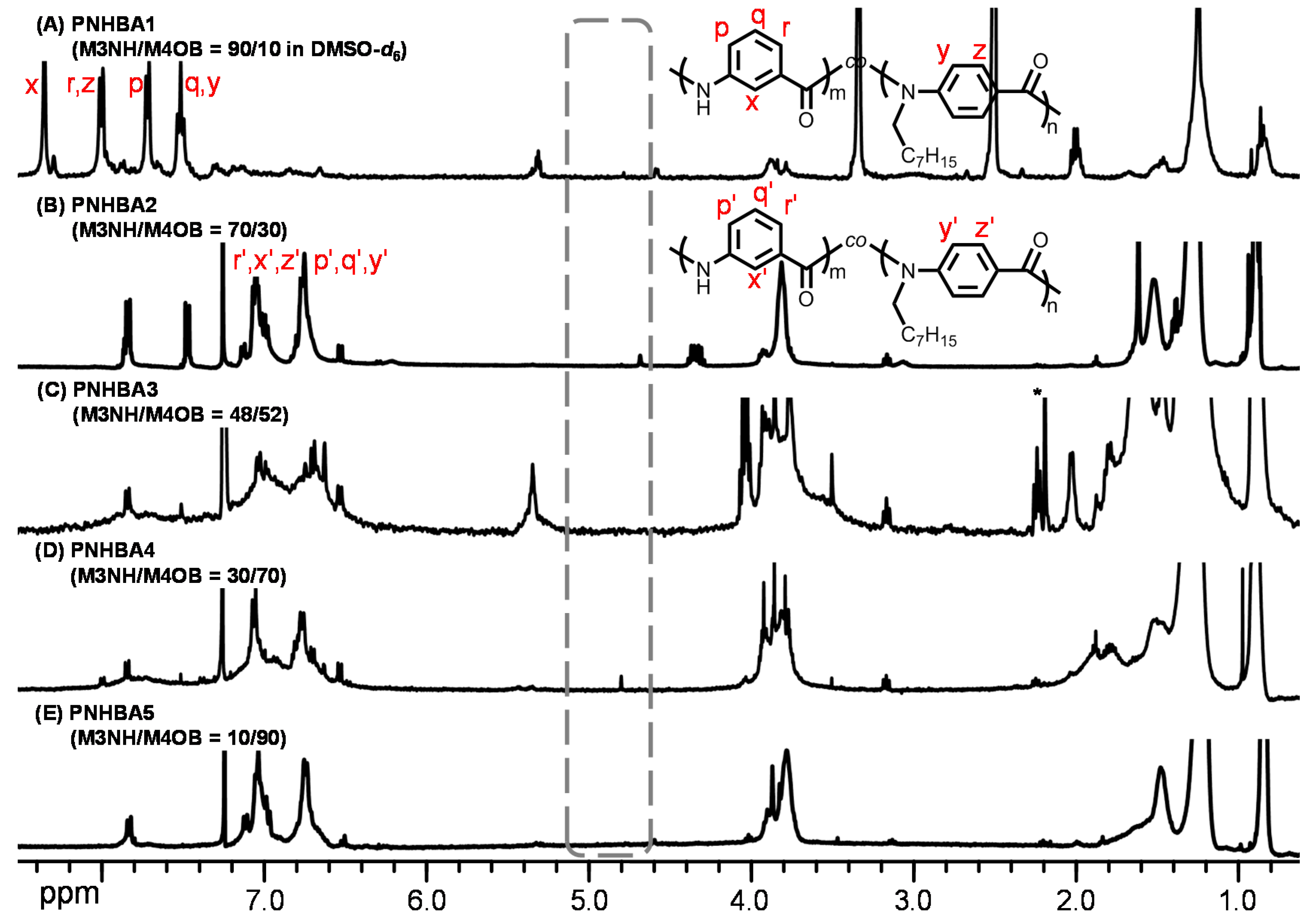
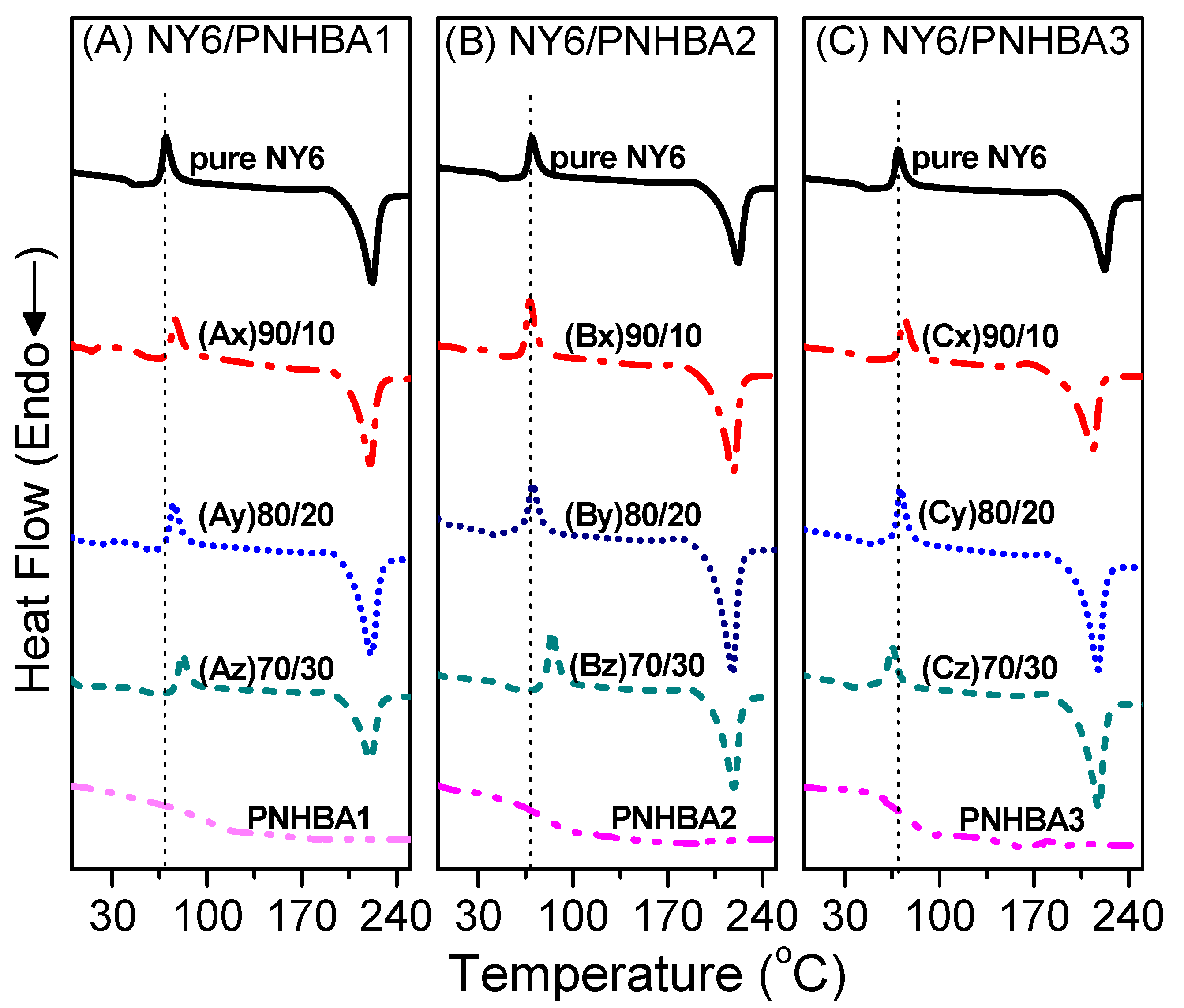

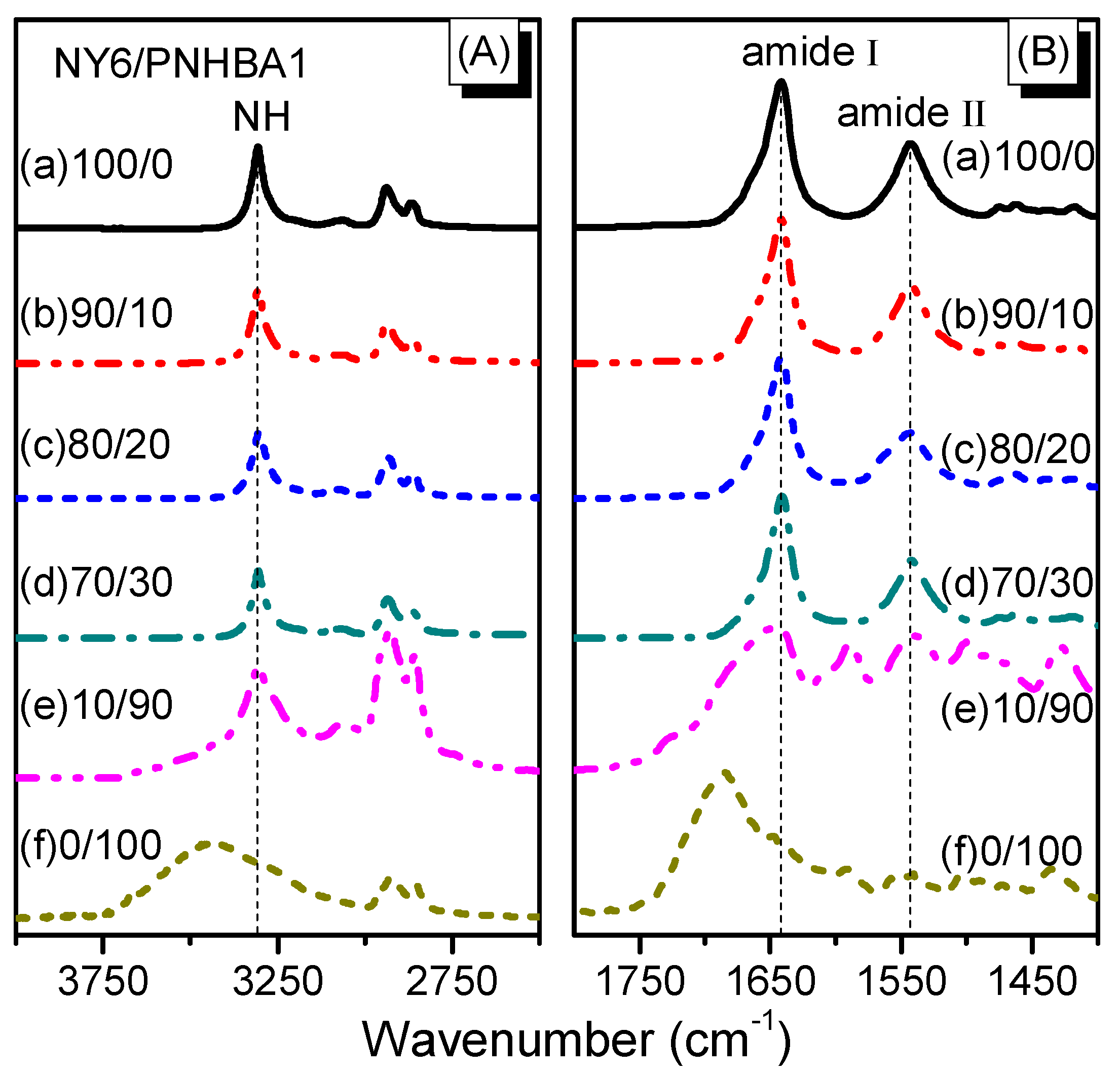
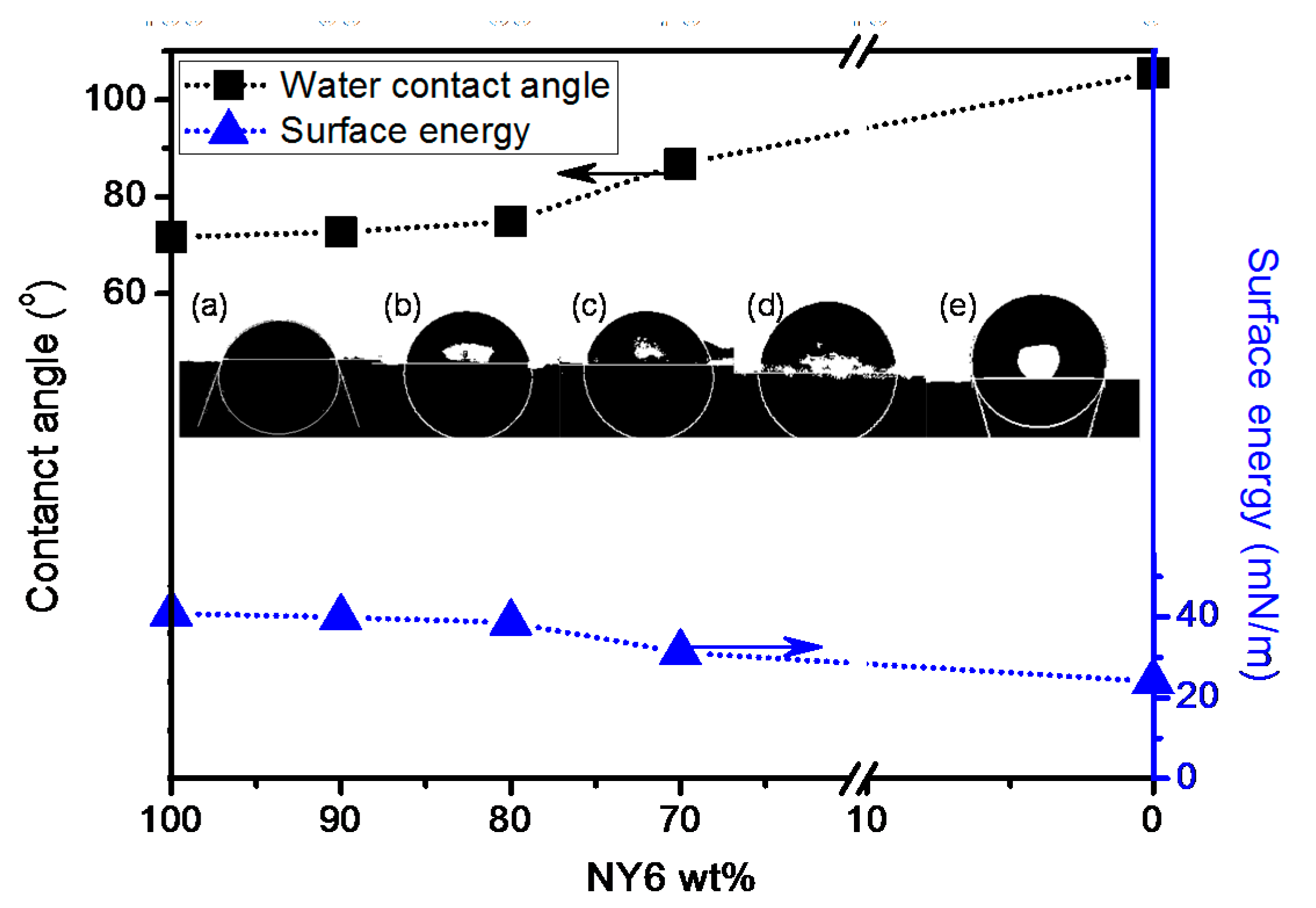

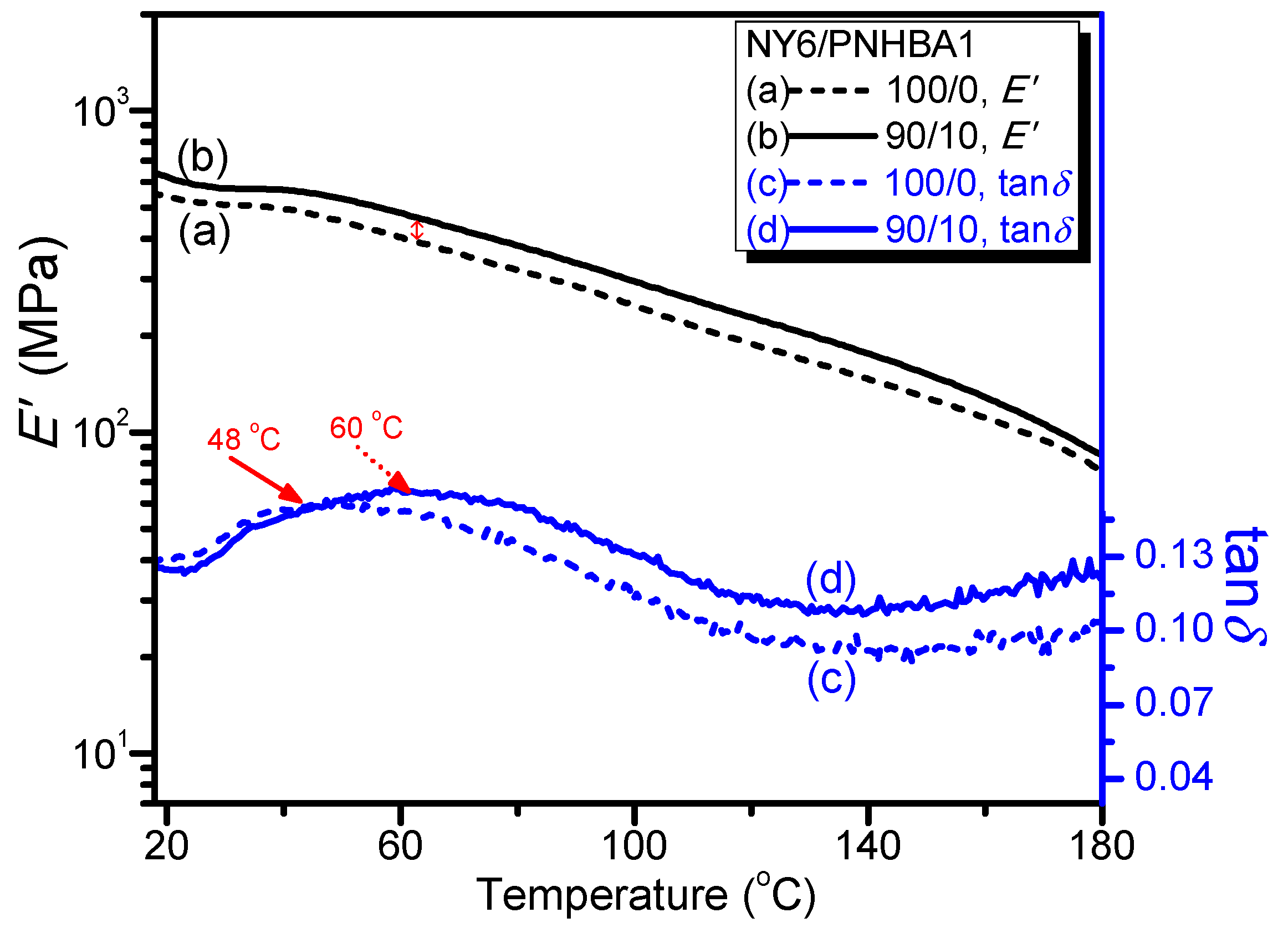
| Samples | F1 a (Feeds) | f1 a (Copolymers) | Mn,th b | Mn,GPC c | Mw/Mn | P12 d | P21 d |
|---|---|---|---|---|---|---|---|
| PBA1 | 0.90 | 0.90 | 13,330 | 12,800 | 1.24 | 0.099 | 0.902 |
| PBA2 | 0.70 | 0.70 | 12,490 | 10,700 | 1.18 | 0.298 | 0.704 |
| PBA3 | 0.50 | 0.48 | 11,640 | 9700 | 1.39 | 0.498 | 0.505 |
| PBA4 | 0.30 | 0.30 | 10,790 | 11,300 | 1.29 | 0.698 | 0.304 |
| PBA5 | 0.10 | 0.10 | 9940 | 10,400 | 1.06 | 0.899 | 0.102 |
| Samples (No.) | Tg (°C) | Tc (°C) | ΔTcg a (°C) | Tm (°C) | ΔHm – ΔHc (J/g) | Xc (%) b |
|---|---|---|---|---|---|---|
| pure NY6 | 44.3 | 69.7 | 25.4 | 220.0 | 26.1 | 11.3 |
| NY6/PNHBA1 | - | - | - | - | - | - |
| 90/10 (Ax) | 50.0 | 76.4 | 26.5 | 220.7 | 22.42 | 9.7 |
| 80/20 (Ay) | 49.3 | 75.2 | 25.9 | 221.7 | 23.14 | 10.1 |
| 70/30 (Az) | 51.8 | 81.6 | 29.8 | 222.6 | 13.52 | 5.9 |
| PNHBA1 | 99.0 | - | - | - | - | - |
| NY6/PNHBA2 | - | - | - | - | - | - |
| 90/10 (Bx) | 41.9 | 68.2 | 26.3 | 218.2 | 34.71 | 15.1 |
| 80/20 (By) | 42.5 | 70.3 | 27.8 | 218.0 | 20.30 | 8.8 |
| 70/30 (Bz) | 50.4 | 84.4 | 34.0 | 218.9 | 19.25 | 8.4 |
| PNHBA2 | 79.9 | - | - | - | - | - |
| NY6/PNHBA3 | - | - | - | - | - | - |
| 90/10 (Cx) | 40.0 | 74.0 | 34.1 | 213.0 | 32.40 | 14.1 |
| 80/20 (Cy) | 42.6 | 71.3 | 28.7 | 217.4 | 37.95 | 16.7 |
| 70/30 (Cz) | 32.2 | 64.8 | 32.6 | 217.0 | 31.96 | 13.9 |
| PNHBA3 | 73.5 | - | - | - | - | - |
© 2017 by the authors. Licensee MDPI, Basel, Switzerland. This article is an open access article distributed under the terms and conditions of the Creative Commons Attribution (CC BY) license (http://creativecommons.org/licenses/by/4.0/).
Share and Cite
Huang, C.-F.; Chen, M.-J.; Lin, C.-H.; Chiang, Y.-W. Synthesis of Well-Defined Poly(N-H Benzamide-co-N-Octyl Benzamide)s and the Study of their Blends with Nylon 6. Polymers 2017, 9, 172. https://doi.org/10.3390/polym9050172
Huang C-F, Chen M-J, Lin C-H, Chiang Y-W. Synthesis of Well-Defined Poly(N-H Benzamide-co-N-Octyl Benzamide)s and the Study of their Blends with Nylon 6. Polymers. 2017; 9(5):172. https://doi.org/10.3390/polym9050172
Chicago/Turabian StyleHuang, Chih-Feng, Miao-Jia Chen, Ching-Hsuan Lin, and Yeo-Wan Chiang. 2017. "Synthesis of Well-Defined Poly(N-H Benzamide-co-N-Octyl Benzamide)s and the Study of their Blends with Nylon 6" Polymers 9, no. 5: 172. https://doi.org/10.3390/polym9050172








